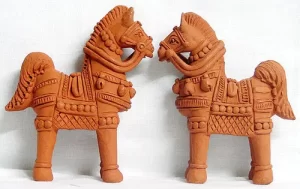Terracotta artform, which is a traditional craft originating from South India. This artform has a rich history, deeply rooted in mythology, culture, and history, and it continues to be a vibrant and integral part of many Hindu temples in regions spanning from Chhattisgarh to Orissa.

Bastar’s terracotta art involves a meticulous and time-honored process that has been handed down through generations. Craftsmen use techniques such as pressing, modeling, baking, carving, and hand-painting to create distinctive designs on each figurine or sculpture. The final products are characterized by a striking mix of color schemes, including black-and-white patterns, as well as vivid reds, yellows, and blues, which breathe life into these clay artworks.
This artform is not only aesthetically beautiful but also holds significant cultural and historical value, making it a cherished treasure for history enthusiasts. The article promises to delve deeper into the history, technique, and influence of Bastar’s terracotta artform, making it a must-read for those interested in this unique and ancient craft.



GIPHY App Key not set. Please check settings